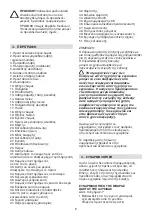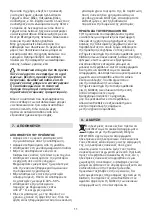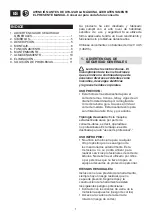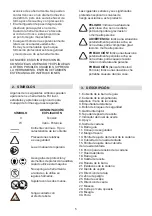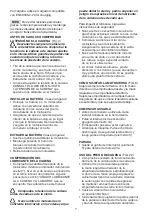
7
back of your hand to push the chain brake
lever/hand guard toward the bar while the
chain is rotating rapidly. Be sure to maintain
both hands on the saw handles at all times.
•
Reset the chain brake back into the RUN
position by grasping the top of the chain
brake lever/hand guard and pulling toward
the front handle.Place the outer tine stamped
A on the right side of the tine shaft. The
stamped side should face in toward tine B.
• Insert the hitch pin (6) into the holes in
order to secure the tines to the tine shaft.
If the chain brake do not stop the
chain immediately, or if the chain brake
will not stay in the run position without
assistance, take the saw to an authorized
service center for repair prior to use.
USING THE CHAIN SAW
Always be sure of your footing and
hold the chain saw firmly with both
hands while the motor is running.
BASIC FELLING, LIMBING, AND
CROSS-CUTTING TECHNIQUES
See figure 9
FELLING A TREE
When bucking and felling operations are being
performed by two or more persons at the same
time, the felling operation should be separated
from the bucking operation by a distance of at
least twice the height of the tree being felled.
Trees should not be felled in a manner that
would endanger any person, strike any utility
line or cause any property damage. If the tree
does make contact with any utility line, the utility
company should be notified immediately.
The chain saw operator should keep on the
uphill side of the terrain as the tree is likely
to roll or slide downhill after it is felled. An
escape path should be planned and cleared
as necessary before cuts are started. The
escape path should extend back and diagonally
to the rear of the expected line of fall. Before
felling is started, consider the natural lean of
the tree, the location of larger branches and
the wind direction to judge which way the
tree will fall. Remove dirt, stones, loose
bark, nails, and staples from the tree.
NOTCHING UNDERCUT
(A NOTCH CUT IN A TREE TO DIRECT
THE FALL) See figure 10
Make the notch 1/3 in diameter of the tree,
perpendicular to the direction of falls. Make the
lower horizontal notching cut first, this will help
to avoid pinching of either the saw chain or the
guide bar when the second notch is being made.
FELLING BACK CUT
(THE FINAL CUT IN A TREE FELLING OPERATION,
MADE ON THE OPPOSITE SIDE OF THE TREE
FROM THE NOTCHING UNDERCUT) See Figure 10
Make the felling back cut at least 50mm higher
than the horizontal notching cut. Keep the felling
back cut parallel to the horizontal notching cut.
Make the felling back cut so as to leave enough
wood to act as a hinge. The hinge wood keeps
the tree from twisting and falling in the wrong
direction. Do not cut through the hinge. As the
felling cut gets close to the hinge, the tree should
begin to fall. If there is any chance that the tree
may not fall in the desired direction or it may rock
back and bind the saw chain, stop cutting before
the felling back cut is complete and use wedges
of wood, plastic or aluminium to open the cut and
drop the tree along the desired line of fall. When
the tree begins to fall, remove the chain saw from
the cut, stop the motor, put the chain saw down,
and then use the retreat path as planned. Be alert
of overhead limbs falling and watch your footing.
LIMBING A TREE
See Figure 11
Limbing is removing the branches from a
fallen tree. When limbing, leave the larger
lower limbs to support the log off the ground.
Remove the small limbs in one cut. Branches
under tension should be cut from the bottom
up, to avoid binding the chain saw.
BUCKING A LOG
See figure 12 - 15
Bucking is cutting a log into lengths. It is
important to make sure your footing is fi rm and
your weight is evenly distributed on both feet.
When possible, the log should be raised and
supported by the use of limbs, logs or chocks.
Follow the simple direction for easy cutting:
– When the log is supported along the entire
length, it is cut from the top (over buck).
– When the log is supported on one end,
cut 1/3 of the diameter from the underside
(under buck). Then make the fi nished cut
by over bucking to meet the fi rst cut.
– When the log is supported on both ends,
cut 1/3 of that diameter from the top (over
buck). Then make the fi nished cut by under
bucking the lower 2/3 to meet the fi rst cut.
–
When bucking on a slope, always stand
on the uphill side of the log. When
cutting through, to maintain complete
control, release the cutting pressure
near the end of the cut without relaxing
your grip on the chain saw handles.
Summary of Contents for CS 48 Li 14
Page 4: ...ii 1 2 3 4 8 7 5 4 5 6 ...
Page 5: ...iii 16 15 14 13 12 11 10 9 18 17 19 ...
Page 6: ...iv 20 21 22 ...
Page 22: ...12 ...
Page 55: ...11 ...
Page 56: ......
Page 112: ......
Page 132: ......
Page 144: ......
Page 166: ......
Page 210: ......
Page 232: ...12 ...
Page 244: ......
Page 256: ......
Page 322: ...STIGA SpA Via del Lavoro 6 31033 Castelfranco Veneto TV ITALY dB LWA Type s n Art N ...


